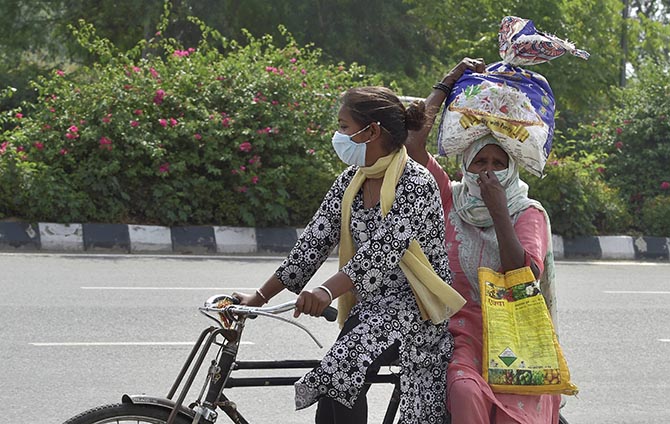 | « Back to article | Print this article |
'How the lockdown is phased out or lifted will tell us if the government has succeeded in its battle against COVID-19.'
'If it cannot sequence its decisions on exiting the lockdown, the few gains secured so far may be frittered away,' says A K Bhattacharya.

With most states favouring an extension of the lockdown, it will be instructive to look back and track the pace and manner in which the government responded to the spread of COVID-19.
The first confirmed case of COVID-19 was reported in India on January 30 and the number rose to three in the following four days, but stayed there for about a month till March 1.
Its rapid spread began from the first week of March and by March 4, the number of confirmed cases had risen to 28.
It was the same day when Prime Minister Narendra Damodardas Modi tweeted that he would not participate in any Holi get-together and also advised fellow citizens to avoid mass gatherings in view of the coronavirus scare.
That was his first attempt at social mobilisation by asking people to voluntarily adopt restraint and caution to tackle the disease.
Holi was to be celebrated on March 9 and 10 in different parts of the country and there was some impact of the advice on people.
The celebrations were a little subdued in many places.
A day after Holi, on March 11, the number of COVID-19 cases in India rose to 62.
The government decided to close its borders by keeping in abeyance all tourist visas, including those for non-resident Indians, from the midnight of March 13 to April 15.
International flights too were cancelled from March 23 to April 15.
On March 14, the first day after blocking all international travels, the number of COVID-19 cases rose to 102.
That number doubled in six days to 244 on March 20.
A day earlier, Modi had addressed the nation and urged the people to maintain social distance with others and stay indoors on Sunday, March 22.
That was his second attempt at social mobilisation asking people to voluntarily stay indoors to stop the spread of the virus.
He even hinted that the Janata Curfew on March 22 would 'prepare us for the forthcoming days'.
What alarmed the government was when the number of cases doubled to 499 in just three days on March 23.
The following day, Modi announced a national lockdown from the midnight of March 24.
He also announced a package of Rs 15,000 crore to provide for healthcare equipment and facilities.
Earlier in the day, Finance Minister Nirmala Sitharaman had announced relaxation in the deadlines for compliance of various economic laws.
Two days later, a package of Rs 1.7 trillion was announced for workers and poor people.
Yet, the enforcement of a national lockdown, within four hours of its announcement, took the nation by surprise and caused immense hardship and disruption particularly for millions of migrant workers, poor people, small firms and informal enterprises.
The sequencing of the announcement of a national lockdown and the provision of basic means of livelihood went wrong.
The situation got better in the following days, but reports of distress are still trickling in from different parts of the country and that shock has left on the poor people deep scars that will take long to heal.
On the whole, the disease containment strategy did make some impact.
From 499 at the end of March 23, the number of confirmed cases doubled only after six days to 1,024 at the end of March 29.
But the following week, the rate of increase quickened - the number of confirmed cases doubled in just four days from 1,024 at the end of March 29 to 2,069 at the end of April 2 and it doubled again in four days to 4,281 at the end of April 6.
However, the pace has slowed since then.
The number of cases doubled only at the end of six days to 8,447 on April 12.
Note that the large movement of migrant workers back to their villages from different cities and towns took place about a fortnight ago and has not led to any spike in the number of cases in Bihar or Uttar Pradesh, two major suppliers of migrant workers.
At the same time, the number of daily tests has been increased.
The cumulative number of tests at over 189,000 indicates that confirmed cases account for only 4.5 per cent of the total tests conducted so far.
This is a much lower figure than most other countries.
Given this pace of the spread of the disease so far and the gradual increase in tests showing a relatively lower incidence of the disease, the government was expected to extend the lockdown by two weeks to completely break the transmission chain of the disease, even though this would deal a big blow to economic activity.
Also, it became clear that there cannot be any relaxation in the norms for socialdistancing, use of masks in public places and avoidance of mass gatherings, so that the disease remains under control.
A bigger challenge lies ahead.
And this is about the strategy for exiting from the lockdown.
Since quoting the Mahabharata has become popular these days, it must be remembered that imposing a lockdown is like entering the Chakravyuh -- entering this formation of the enemy camp, like in the epic, is as important as getting out of it unscathed.
How the lockdown is phased out or lifted will tell us if the government has succeeded in its battle against COVID-19.
If it cannot sequence its decisions on exiting the lockdown, the few gains secured so far may be frittered away.